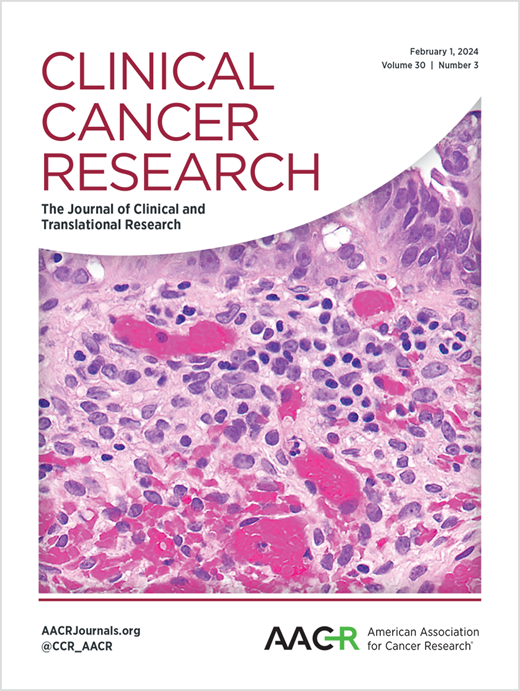Cabozantinib联合Atezolizumab治疗晚期进展性内分泌恶性肿瘤:一项多队列、一揽子、II期试验(CABATEN/GETNE-T1914)
IF 10.2
1区 医学
Q1 ONCOLOGY
引用次数: 0
摘要
背景:多激酶抑制剂(MKIs)在内分泌肿瘤中已显示出疗效,并且在其他肿瘤中已注意到与免疫检查点抑制剂(ICI)的协同作用。患者和方法:这是一项前瞻性、多中心、开放标签、Simon 2期优化设计的II期研究,包括6个队列的晚期难治内分泌和神经内分泌肿瘤患者:肺高分化神经内分泌肿瘤(lungNET)、间变性甲状腺癌(ATC)、肾上腺皮质癌(ACC)、嗜铬细胞瘤/副神经节瘤(PPGL)、高分化胃胰腺NET (GEP-NET)和3级肺外神经内分泌肿瘤(G3 EP-NEN)。患者接受atezolizumab 1200mg IV Q3W + cabozantinib 40mg /d PO,直到疾病进展或不可接受的毒性。主要目标是RECIST 1.1的总缓解率(ORR)。结果2020年10月至2022年12月,纳入93例患者。ATC的ORR为14.3% (95% CI:1.8-42.8) (N=14);ACC患者占8.3% (95% CI:1.0-27.0) (N=24);PPGL组(N=13) 15.4% (95% CI:1.9-45.5), GEP-NET组(N=24) 16.7% (95% CI: 4.7-37.4)。LungNET和G3 EP-NEN无反应。ATC组反应持续时间(DoR)为20.4个月;ACC 13.1个月;PPGL组12.2个月,GEP-NET组15.8个月。ATC和ACC的12个月生存率分别为47.6%和47.6%。未观察到意外毒性。结论cabozantinib和atezolizumab在侵袭性和预处理的ACC和ATC中显示出良好的ORR和初步的长期生存率,值得进一步研究。本文章由计算机程序翻译,如有差异,请以英文原文为准。
Cabozantinib plus Atezolizumab in Advanced, Progressive Endocrine Malignancies: A multi-cohort, Basket, Phase II Trial (CABATEN/GETNE-T1914).
BACKGROUND
Multikinase inhibitors (MKIs) have shown efficacy in endocrine neoplasms and synergism with immune-checkpoint inhibitors (ICI) has been noted in other tumors.
PATIENTS AND METHODS
This is a prospective, multi-center, open-label, Simon 2 stage optimal design, phase II study including patients with advanced and refractory endocrine and neuroendocrine neoplasms in 6 cohorts: lung well-differentiated neuroendocrine tumors (lungNET), anaplastic thyroid cancer (ATC), adrenocortical carcinoma (ACC), pheochromocytoma/paraganglioma (PPGL), well-differentiated gastroenteropancreatic NET (GEP-NET), and grade 3 extrapulmonary neuroendocrine neoplasms (G3 EP-NEN). Patients received atezolizumab 1200 mg IV Q3W plus cabozantinib 40 mg/day PO until disease progression or unacceptable toxicity. The primary objective was overall response rate (ORR) by RECIST 1.1.
RESULTS
From October 2020 to December 2022, 93 patients were included. ORR was 14.3% (95% CI:1.8-42.8) in ATC (N=14); 8.3% (95% CI:1.0-27.0) in ACC (N=24); 15.4% (95% CI:1.9-45.5) in PPGL (N=13) and 16.7% (95% CI: 4.7-37.4) in GEP-NET (N=24). LungNET and G3 EP-NEN had no responses. Duration of response (DoR) was 20.4 months in ATC; 13.1 months in ACC; 12.2 months in PPGL and 15.8 months in GEP-NET. Survival rates at 12 months in ATC and ACC were 47.6 %and 47.6 % respectively. No unexpected toxicity was observed.
CONCLUSION
Cabozantinib and atezolizumab were safely administered and showed promising ORR and preliminary long-term survival rates were observed in aggressive and pretreated ACC and ATC, which warrants further investigation.
求助全文
通过发布文献求助,成功后即可免费获取论文全文。
去求助
来源期刊

Clinical Cancer Research
医学-肿瘤学
CiteScore
20.10
自引率
1.70%
发文量
1207
审稿时长
2.1 months
期刊介绍:
Clinical Cancer Research is a journal focusing on groundbreaking research in cancer, specifically in the areas where the laboratory and the clinic intersect. Our primary interest lies in clinical trials that investigate novel treatments, accompanied by research on pharmacology, molecular alterations, and biomarkers that can predict response or resistance to these treatments. Furthermore, we prioritize laboratory and animal studies that explore new drugs and targeted agents with the potential to advance to clinical trials. We also encourage research on targetable mechanisms of cancer development, progression, and metastasis.
 求助内容:
求助内容: 应助结果提醒方式:
应助结果提醒方式:


